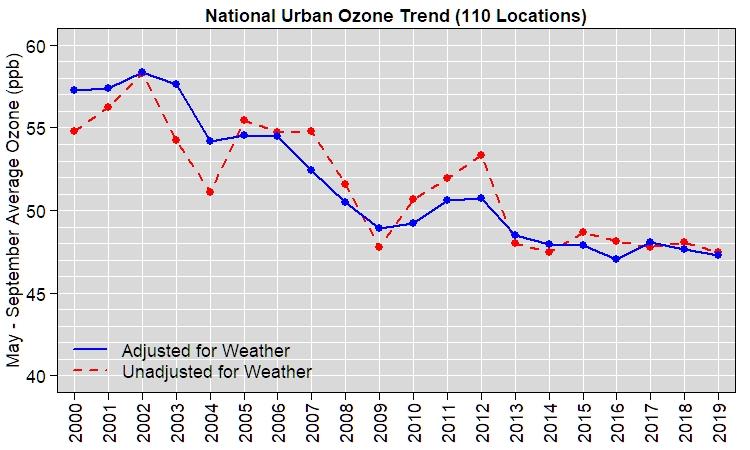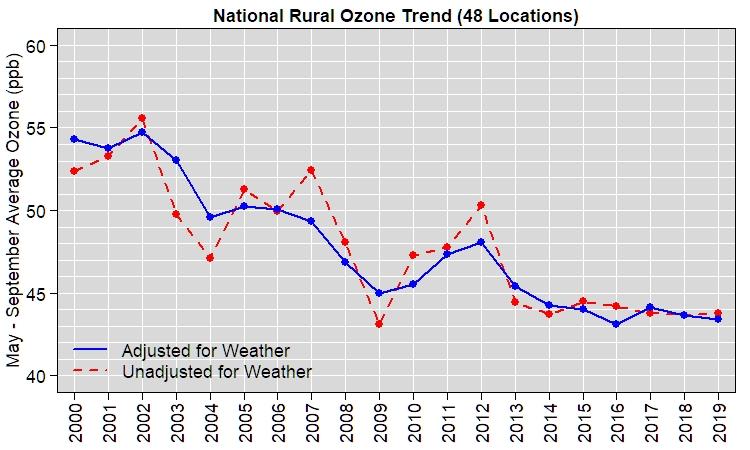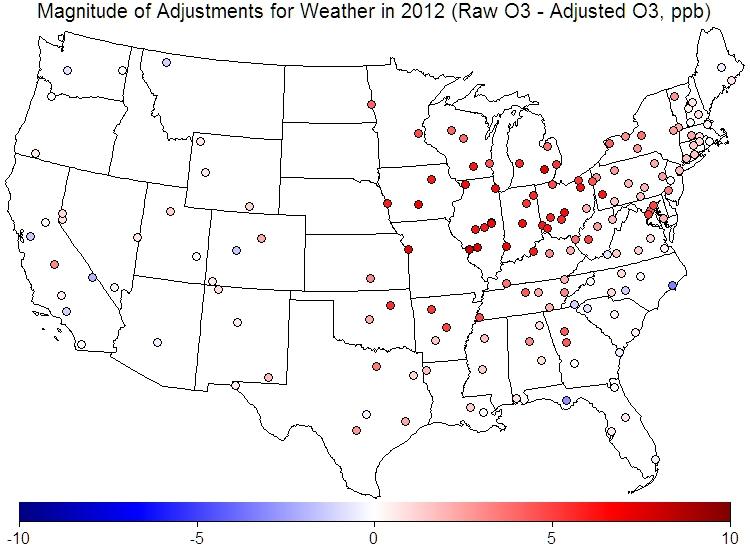Trends in Ozone Adjusted for Weather Conditions
Variations in weather conditions play an important role in determining ozone concentrations. Ozone is more readily formed on warm, sunny days when the air is stagnant. Conversely, ozone production is more limited when it is cloudy, cool, rainy, or windy. EPA uses a statistical model to adjust for the variability in seasonal ozone concentrations due to weather to provide a more accurate assessment of the underlying trend in ozone caused by emissions.
The graphs below show the national trends in the May - September average of the daily maximum 8-hour ozone concentrations from 2000 to 2019 in urban and rural locations, respectively. The dotted red lines show the trend in observed ozone concentrations at selected monitoring sites, while the solid blue lines show the underlying ozone trend at those sites after removing the effects of weather. The solid blue lines represent ozone levels anticipated under average weather conditions and serve as a more accurate assessment of the trend in ozone due to changes in precursor emissions. For example, below average temperatures and above average humidity in the Eastern US in the summer of 2009 contributed to decreased ozone formation, while above average temperatures and below average humidity in the Central and Eastern US in 2012 contributed to increased ozone formation. The statistical model accounts for these effects by adjusting the seasonal average ozone trend upward in 2009 and downward in 2012.

 Summertime weather patterns may differ across various regions of the US, therefore it is often useful to examine regional ozone trends. For example, the summer of 2009 was dominated by cooler than average weather in the Northeast region, but warmer than average weather in the Northwest region. Thus, the trends in these two regions are adjusted in opposite directions in 2009. Here are zip files of regional and location-specific trend graphs:
Summertime weather patterns may differ across various regions of the US, therefore it is often useful to examine regional ozone trends. For example, the summer of 2009 was dominated by cooler than average weather in the Northeast region, but warmer than average weather in the Northwest region. Thus, the trends in these two regions are adjusted in opposite directions in 2009. Here are zip files of regional and location-specific trend graphs:
- Ozone trends adjusted for weather, shown by climate region (ZIP)(1 MB, 5/7/2020)
- Ozone trends adjusted for weather in all 158 locations (ZIP)(23 MB, 5/7/2020)
The statistical model used by EPA to determine the adjustments to the ozone trend is fit independently in each location using local ozone and weather data. However, the results tend to have a strong geographic coherence. The maps below illustrate the spatial pattern in the adjustments to the observed ozone trend across the nation in 2009 and 2012.
Additional Resources
Maps of the annual adjustments to the observed ozone trend for 2000 to 2018 (ZIP) (4 MB, 7/16/2019)
Technical Approach - Louise Camalier, William Cox, and Pat Dolwick. The Effects of Meteorology on Ozone in Urban Areas and their use in Assessing Ozone Trends. Atmospheric Environment, Volume 41, Issue 33, October 2007, pages 7127-7137.
Reference - William Cox and Shao-Hang Chu. Assessment of Interannual Ozone Variation in Urban Areas from a Climatological Perspective. Atmospheric Environment, Volume 30, Issue 14, July 1996, pages 2615-2625.


